Longtime Companion
by Sonny & the Sunsets
[Music CD]
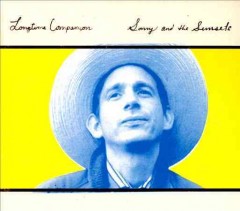
view/request
Step one after a break up is to write and record a country album. San Francisco native Sonny Smith has followed this guide, only he’s unexpectedly added a little bounce, shuffle and humor. I saw Sonny & the Sunsets on the Longtime Companion tour at Flywheel in Easthampton, MA and he played a number of songs from this record alongside his usual catchy, sometimes surfy, melodic fair. He also took off his pants.
Smith’s deadpan delivery over the groovy “I See the Void” had me sold on his version of country music. He and the Sunsets played a mini set of their hip take of twang with nods to Buck Owens, The Flying Burrito Brothers (the self-titled number takes me to that “Hot Burrito no. 2″ place with steady soul bass over a simple chord change) and even a little Beachwood Sparks.
For a record dealing with heartbreak and separation, Sonny & the Sunsets offer the listener an enjoyable experience and while forging new ground within a classic genre.
Reviewed by Jason
Tagged: Country music, Indie rock, Rock music
Waking Sleeping Beauty
[DVD]
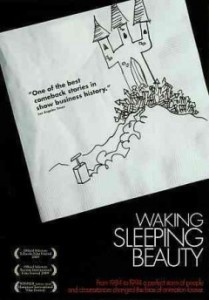
view/request
In Waking Sleeping Beauty, we go behind the doors of the Disney animation building and see an equal display of creative brilliance and management melodrama. As the 1970’s drew to a close, the legendary animation studio was producing anemic box office returns (by Disney standards) and those in charge of the purse strings viewed its limping continuation simply as a tribute to Walt’s legacy. Shifts in corporate leadership created new challenges to the once easy going, hippie-ish department and as a result, the company reached a range of highs and lows.
This film features interviews with animators, directors, composers and executives. In addition, the curtain is lifted and we’re granted access to all sorts of behind the scenes footage. We see the animators at work and goofing around, early film cuts and cells, actors recording voice-overs, corporate lectures, between take banter of Michael Eisner’s television introductions and even funeral speeches. Waking Sleeping Beauty is a film for anyone who is interested in the history of the Disney empire and ever wondered how the magic is really created.
Reviewed by Jason
Tagged: Animation, Disney, Documentary, Film
California Split
[DVD]
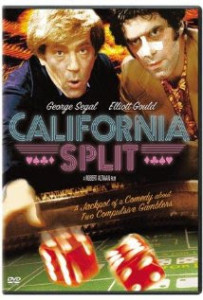
view/request
George Segal and Elliott Gould star in California Split, my all time favorite Robert Altman film and one of the best from the 1970’s. This dark, buddy comedy is centered around Bill Denny & Charlie Waters, two men who get sucked into the world of gambling. After Bill falls deep in debt to his bookie, he sells off several possessions so he and Charlie can make an all-in trek to Reno. They eventually find themselves in a tacky casino and in a dramatic, high stakes poker match.
Segal and Gould are the ultimate on screen duo with a perfect comedic volley and excellent chemistry. Additionally, this 1974 movie comes in when Altman was on top of his creative game. The director’s signature usage of wide range audio recording gives the picture an incredible depth and a real sense of place. The conversations from the extras and bit characters are always audible and usually rather interesting.
Ultimately, the story of California Split asks, does money really equal happiness?
Reviewed by Jason
Tagged: 1970s, Comedy, Drama, Feature film
Kisses on the Bottom
by Paul McCartney
[Music CD]
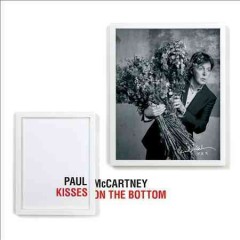
view/request
It’s been an awfully long time since Macca has been discussed on the Forbes Library staff picks blog. So, here I am to recommend a romantic offering from the melodious, ex-Beatle. Kisses on the Bottom, Paul’s tribute to the music he heard around the house as a boy, is a marvelous collection of standards with two originals tacked on for good measure. Diana Krall, Stevie Wonder, Eric Clapton, Robert Hurst, John Pizzarelli and Karriem Riggins are among the many fine musicians who make up McCartney’s backing band.
The title comes from a lyric from the opening tune, “I’m Gonna Sit Right Down and Write Myself a Letter” by Fats Waller. The introduction’s syncopated piano line, upright bass and brushes on the drum kit, set the tone for this swinging affair. Recorded at the famed Capitol Studios on Hollywood and Vine, Paul, singing with Nat King Cole’s microphone, taps into the crooning spirit of yesteryear.
Highlights include “It’s Only a Paper Moon”, “Ac-Cent-Tchu-Ate the Positive”, “My Valentine” (a Paul original), “The Inchworm”… well, I recommend ’em all!
Reviewed by Jason
Tagged: Beatles, Jazz, Standards
F for Fake
[DVD]
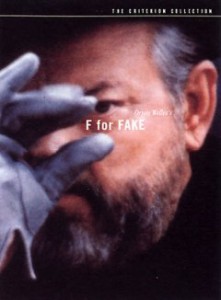
view/request
Join Orson Welles in a one of a kind cinematic experience that examines many shades of the truth. 1973’s F for Fake is presented as an essay film; most definitely the first of its kind. Welles narrates the documentary often on camera with the appearance of a worldly travel host. While delivering literary quotations in a Brechtian style, interviewing subjects and delivering personal tales in his larger than life/life of the party personality, he incorporates a wide range of footage (including bit-lits from his recently abandoned projects) and edits various film formats in dramatic fashion.
At the heart of the movie, Welles discusses the parallels between notorious art forger Elmyr de Hory and the biographer Clifford Irving. Irving who settled in Ibiza working on the de Hory tale, later went on to create a fake of his own: a false biography of Hollywood tycoon Howard Hughes. The director weaves these and other scandals and also shines the light on his infamous War of the Worlds radio broadcast.
Though the content in F for Fake is presented as fact, the masterful Welles, a fan of the slight of hand, cannot resist the urge to play with his audience.
Reviewed by Jason
Tagged: Documentary, Drama
Headquarters
by the Monkees
[Music CD]
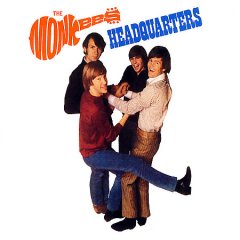
view/request
To earn the Monkees the right to play on their own records, Michael Nesmith’s fist had punch a wall accompanied with the threat “that could’ve been your face”. Thankfully the powers that be relented because Headquarters, the band’s third release, is possibly their most unified, spirited effort.
And now a bit about the personnel… Nesmith handles much of the guitar duties, the classically trained Peter Tork plays keyboards, guitars, basses and banjos, Mickey Dolenz sits behind the drum kit and dabbles on the guitar and Davy Jones shakes a mean tambourine and maraca. All four sing. Producer Chip Talyor plays the occasional bass.
Michael Nesmith, asserting himself as the band’s most prolific songwriter, contributes the twangiest of tunes including “Sunny Girlfriend” and “You Just May Be the One”. Peter Tork writes “For Pete’s Sake”, the groovy number that became the track which rolled over the end credits of the band’s television program. Davy tackles the Hildebrand/Keller number “Early Morning Blues and Green” replete with Wurlitzer electric piano and a wild, distorted organ. Mickey Dolenz sings and writes the psychedelic “Randy Scouse Git” (included on most Monkees “best of” compilations), a song that was inspired by the band’s trip to London and hanging out with the original Fab Four.
Headquarters sounds like a band working together trying to find their sound. It’s garage, it’s pop, it’s joyful.
Reviewed by Jason
Tagged: 1960s rock music, Pop music
Bobby Charles
by Bobby Charles
[Music CD]
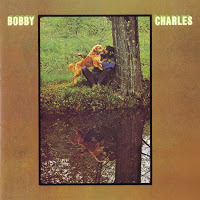
view/request
No album better represents the sound of a bunch of guys hanging out, having good times and recording music than Bobby Charles’s self-titled album. Charles, celebrated for writing “See You Later Alligator” for Bill Haley and “Walking To New Orleans” for Fats Domino, found himself relaxing with The Band in Woodstock, New York in ’71. The circumstances for his east coast residence have something to do with a divorce and hiding out from a Nashville marijuana bust.
The Band (with Dr. John in tow) back Charles through a set of lazy melodies with New Orleans influence and a loose, country bounce. With this all-star line-up, it’s really not a shocker that the backing is as cool as can be. However, it’s Charles’s voice that shines brightest. There is a exceptional fullness and soul in each word that Charles projects and yet he sometimes gives the listener the impression that he’s singing softly, almost narrating a local tale.
The feeling of living out in the country, slowing down and finding peace are intertwining themes throughout Bobby Charles. On “Small Town Talk”, after a whistled intro, Charles croons “and it’s small town talk, you know how people are/they can’t stand to see someone else doing what they want to”. “Tennessee Blues”, the album’s closer, is also no exception to this sensibility. The song is so perfect and timeless, one might imagine Charles ripped it from a book of standards at least 25 years earlier. With one of my all time favorite vocal performances (Doug Sahm’s version is definitely worth hearing as well), Charles sings:
Find me a spot on some mountain top
With lakes all around me
With valley and streams and birds in the trees
And lakes that surround me
A place I feel loose
A place I could lose these Tennessee Blues
Reviewed by Jason
Tagged: Country music, Folk music, New Orleans, Rock music, Soul music
Dr. John Teaches New Orleans Piano
[DVD]
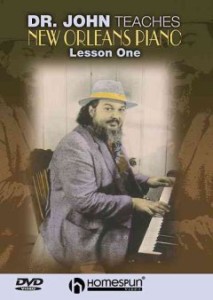
view/request
I didn’t learn to play New Orleans style piano watching this DVD. You might, if you are already a competent pianist, or simply more patient than I am, but this is a rewarding movie whether you intend to become rock and roll pianist or not. Dr. John is an amazing musician; when he plays it looks easy, but just try following along at the piano!
Dr. John looks relaxed (though often worried, as if something else is on his mind). At times he hardly seems to move—but the piano keys move, quickly, and in syncopation, and the music is wonderful. He plays Frankie and Johnnie, C. C. Rider, Blueberry Hill, and others, playing each in some flavor of the New Orleans Rock and Roll, Fats Domino inspired, playing for which he is known. We are given an overhead view of the piano keyboard, as well as a more conventional angle from the side, which lets you really appreciate the fluidity with which the Doctor plays, and is invaluable if you want to try playing his licks yourself. He breaks many of the tunes down, playing the left hand or right hand parts separately, slowing down the tempo, or demonstrating alternative turn around and improvisations. He discusses what riffs are easiest when accompanying your own voice, and briefly describes the interaction between the pianist and the other members of the band.
I really enjoyed this DVD. In fact, I think I’ll probably revisit it in a few months—after I’ve practiced the piano a bit more!
Reviewed by Ben
Tagged: Documentary, Instruction, Music, Rock music
Walk Away Renée/ Pretty Ballerina
by The Left Banke
[Music CD]
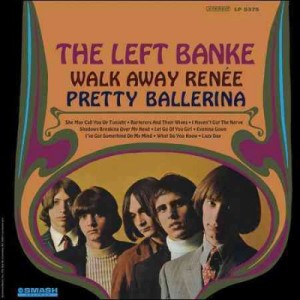
view/request
Fans of The Zombies, The Free Design or The Hollies will most likely enjoy the soft, baroque sounds of The Left Banke. Though the two hits that divide up the album’s title are the obvious stand outs, the entire recording is a strong set of 1960’s magic. The arrangements throughout are harmonically sophisticated and borrow heavily from classical music.
This New York quintet sounds decidedly British and I’d liken Steve Martin Caro’s voice to The Zombies frontman, Colin Blunstone. Both singers have a perfect, gentle tenor with unbelievable range. Martin Caro and many members of the group share songwriting and lead vocal duties. Michael Brown, then a teenager, is responsible for the hits on the record. He managed to compose music that blends youthful angst and longing with haunting melodies.
Other highlights include “I’ve Got Something On My Mind” and “Shadows Breaking Over My Head”, which come close to rivaling the title tracks.
I give this Left Banke album an A+++, eighteen stars, two thumbs up and three golden tickets.
Reviewed by Jason
Tagged: 1960s rock music
The Artist
[DVD]
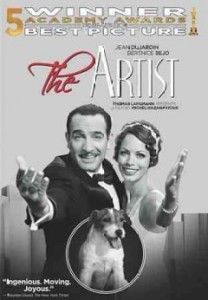
view/request
I had heard great things about Michel Hazanavicius’ award winning silent film The Artist. How could I not have? The film won five Oscars, three Golden Globes, and a host of other awards and critical praise. And yet, I was nervous about seeing the film. A silent film made in 2011? Was it just a gimmick? Just a superficial imitation of an earlier error?
There is no doubt that the film is intended as an homage to older films. The film is presented in black and white and everything from the acting, to the intertitles, the score, and even the aspect ratio of the screen is designed to resemble the films of the silent era. And yet, the film feels quite modern, in part, because of the self-awareness it brings to its imitation, but also because the film looks at Hollywood in the late twenties in a manner which could only be done in hindsight. In many ways The Artist has more in common with Singing in the Rain, another great film about Hollywood’s transition to talkies, than it does with any silent film.
And, much as with Singing in the Rain, you don’t actually have to be familiar with films of the silent era to appreciate The Artist. The film is well made, the acting is great, the period costumes are a joy. The characters are larger than life, but sympathetic and likable. They are caricatures, but this is so well done as to be an asset.
I really enjoyed The Artist. It’s funny, stylish, and clever. Recommended for film lovers or anyone looking for something a little different.
Reviewed by Ben
Tagged: 1920s, Feature film, Silent film
I Knew It Was You: Rediscovering John Cazale
by Richard Shepard
[DVD]
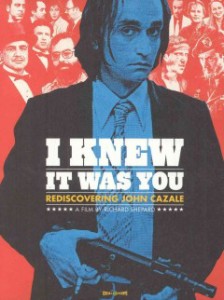
view/request
Though John Cazale isn’t a household name, the five feature films he appeared in during his short life are movies that are regarded as perennial American classics. The character actor can be found in The Godfather, The Conversation, The Godfather Part II, Dog Day Afternoon and The Deer Hunter. To many he’s “the guy who played Fredo”, but to those who knew him and worked alongside, Cazale was an actor unlike any.
This short documentary consists of film clips, archival photos and footage and candid interviews from co-stars Meryl Streep (Streep and Cazale were also romantically involved), Al Pacino, Robert De Niro and Gene Hackman. Directors Francis Ford Coppola and Sidney Lumet and followers Steve Buscemi, Philip Seymour Hoffman and Sam Rockwell are also featured providing analysis and admiration of Cazale’s artistry.
After watching I Knew It Was You, I feel compelled to revisit these films and look a little closer at this mysterious supporting character.
Reviewed by Jason
Tagged: Documentary
Moonstruck
[DVD]
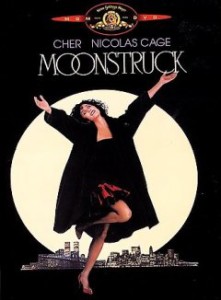
view/request
Norman Jewison’s Moonstruck is a film that’s been on cable television throughout much of my life, sitting on the shelves of various video stores and more recently, hanging out in the Forbes Library. The box artwork featuring Cher with her outstretched arms has always rubbed me the wrong way, perhaps signalling some sort of a cheeseball factor.
Recently I read an
interview with director Wes Anderson where he discussed his favorite New York films and to my surprise
Moonstruck made the cut. Jewison, who was a mentor to Hal Ashby, directs a delightful, modern day fairy tale filled with comedy, romance, beautiful and subtle camera work, brilliant character actor performances and just the right amount of nostalgia. Also standing out is the pitch-perfect dialog. John Patrick Shanley (other credits include
Joe Vs. the Volcano and
Doubt) creates a somewhat realistic family unit that is forever bickering with one another.
The story: Loretta (Cher), who has recently agreed to marry Johnny (Danny Aielo), is asked to track down her fiance’s estranged brother Ronny (Nicholas Cage) and invite him to their upcoming wedding. While Johnny is in Italy tending to his ailing mother, Loretta and Ronny wind up having an intense love affair. Chaos ensues!!! We also have Olympia Dukakis, Vincent Gardenia and John Mahoney in memorable supporting roles.
They say you can’t judge a book by its cover… and I think I’m now learning that you also shouldn’t judge a film by it’s DVD or VHS artwork!
Reviewed by Jason
Tagged: Comedy, Drama, Feature film












